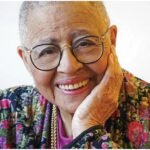Holnicote House, a historical site in Somerset, UK, once served as Britain’s first mixed-race orphanage. Carol Edwards, who lived there as a child, recently shed light on this hidden chapter of history. Alongside 25 other children, she spent her early years in this unique home created for “brown babies,” a term used by U.S. newspapers for mixed-race children born to white British mothers and African American GIs during World War II.
A Little-Known Chapter of History
After a recent tour of Holnicote House, Edwards felt compelled to share her story. “This part of our history has been overlooked,” she stated. During her time there, she experienced love and care, stating, “They cared for us and loved us all. We were all treated the same and never made to feel different.” Her reflections highlight the importance of recognizing the struggles and triumphs of the children who lived there.
During the war, around 2,000 mixed-race children were born at a time when the Black population in the UK was only 7,000 to 10,000. This group of children increased the Black British population by approximately 25%. Unfortunately, many of these children faced a difficult fate, as about half were given up for adoption. Holnicote House was established as a haven specifically for them when Somerset County Council requisitioned the building in 1943.
The Experience of ‘Brown Babies’
Edwards’ experience at Holnicote House was positive, but many other children faced hardships. Dr. Chamion Caballero, cofounder of the Mixed Museum, noted that these children faced significant stigma. Being both mixed-race and born out of wedlock marked them as social problems in the eyes of the authorities. Often, they were isolated in predominantly white areas, where they experienced discrimination and lacked connections to Black communities.
Even in urban Black settings, many faced rejection, being labeled as “not Black enough.” The cultural landscape was challenging for these children, as the U.S. military at the time was still segregated. Although Black GIs were well-received by some locals, attitudes changed when mixed-race children entered the picture.
Discovering Identity Through Music
For Carol Edwards, discovering her identity as a Black woman was a gradual process. Growing up, she was often the only Black person in her school. “I discovered who I was through music,” she shared, explaining how artists like Sarah Vaughan and Nina Simone helped her find a sense of belonging. Music became a crucial outlet for understanding her identity.
Her friend Ann Evans, who also lived at Holnicote House, experienced a similar journey. Adopted by a Welsh family, she faced racial prejudice but found strength in her family’s support. Both women later sought to reconnect with their biological families, and their shared experiences at the orphanage have left a lasting impact on their lives.
Preserving a Significant Legacy
During her recent visit to Holnicote House, Edwards noticed a lack of recognition for the orphanage’s history. She pointed out to the new owner that there were no photographs or references to its significance. The owner promised to address this, ensuring that the legacy of Britain’s first mixed-race orphanage will not be forgotten.
As Edwards reflects on her journey, she emphasizes the importance of sharing these stories. The experiences of “brown babies” born to Black GIs and white mothers deserve recognition. Their strength and resilience showcase the unbreakable spirit of those who lived through challenging times.




